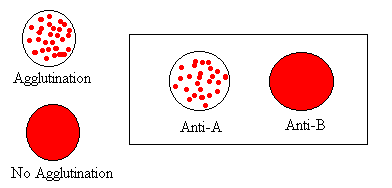
Chapter 14 Blood
You put a tube of whole blood in a centrifuge. It is about 56% red cells. Should
you be concerned?
Yes! This person has polycythemia - too many erythrocytes,
and his blood will have trouble passing through his vessels!
What do you call the layer found in between the plasma and the erythrocytes,
and what is in it?
The buffy coat - contains leukocytes and platelets
A man weighs 176 pounds. What is his approximate blood volume?
1 kg = 2.2 lbs. 176/ 2.2 = 80 X 0.08 = 6.4
kg or about 6.4 liters
What does plasma have that serum does not?
Clotting factors
What does a hemocytoblast make?
It is the stem cell that produces erythrocytes,
platelets and all the different leukocytes.
You decide you don't like the fact your blood has iron, so you remove it. How
well does your hemoglobin work? It will still
transport carbon dioxide which binds to the globin portion of the molecule, but
the oxygen binds to the iron in your hemoglobin, so, except for what is
dissolved in the plasma, your blood is not carrying oxygen. But look on the
bright side, now carbon monoxide won't hurt you!
Your snooty, rich little cousin says her blood is blue. You tell her that you
could make it appear blue. What would you do? Decrease
her oxygen supply - her blood will get darker and appear blue through her mucous
membranes and skin.
Why do red blood cells have a short life span?
Because without a nucleus, they have no genes with
which to make enzymes for metabolism and cell repair.
What happens to hemoglobin when a RBC dies?
What happens to bilirubin when the ducts from the liver to the small intestine
becomes blocked?
It can't enter the intestines as it normally does. It
backs up in the blood, and turns your tissues yellow, a condition known as
jaundice. As a side line - your stools would be grayish instead of brown.
What is anemia?
A decrease in the blood's ability to carry oxygen. It
can be due to a low number of erythrocytes, or to the fact that the erythrocytes
have too little hemoglobin.
Why does a person who is anemic feel
"tired all the time"?
Remember cellular respiration from A&P I? We use
oxygen as the final electron acceptor at the end of the electron transport
chain. That's the part that turns all the NADH and FADH2 into ATP. IF we don't
have enough oxygen, we don't make very much ATP. We don't have enough energy to
do what needs to be done, and we feel tired.
What is sickle cell anemia?
It is an inherited disease where two amino acids in
the beta chains of the globin portion of hemoglobin have been altered. When the
cell is exposed to too low an oxygen level, the hemoglobin crystallizes, pulls
on the cell membrane, and the erythrocyte takes on a sickle or crescent moon
shape. This is not a good shape for passing through small vessels, and these
cells can block vessels. It is a painful, and life threatening disease.
What is polycythemia? When can it be good, and when can it be harmful?
Polycythemia occurs when a person's blood has too many red cells. It helps
in conditions where oxygen levels are low, as in high altitudes, and it
increases endurance, but if it increases too much, the blood becomes too thick
to flow through the blood vessels properly.
Your doctor requests a "differential white blood cell count" from the lab.
What does he suspect if he sees abnormally high numbers of:
Neutrophils - bacterial infection
Eosinophils - parasitic worm infection or allergic
reaction
Lymphocytes - mononucleosis, (or whooping cough or
hairy cell leukemia)
What are major histocompatibility antigens and where are they found? How do we
use them?
These are antigens found on the surface of every cell
in the body that has a nucleus. These antigens identify our tissues as "self" to
our immune system, and we look to match these antigens when we do organ
transplants.
You go on a starvation diet, and your plasma albumin levels drop. What would
you expect to happen?
Without the albumins to hold water in your blood
vessels, the fluid would leak into your tissues, you would experience edema, and
have a decreased blood volume and blood pressure.
A person has Type O blood. What antibodies does he produce? What types of
blood could he receive?
He produces antibodies against type A and B. He could
only receive type O blood, or he would destroy any red cells he was given.
What is the blood type of the person shown here?(
This person has type A blood. The serum in the well on the left contains
antibodies against type A antigens. Since the blood clumped, we know that person
had the A antigen for the antibodies to bind to. Since the antibodies against
type B in the well on the right had no effect, we know that person does not have
the type B antigen.)
